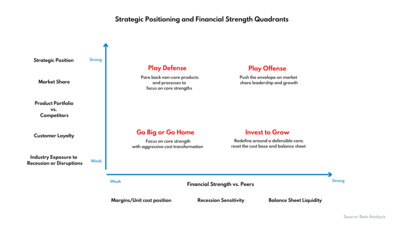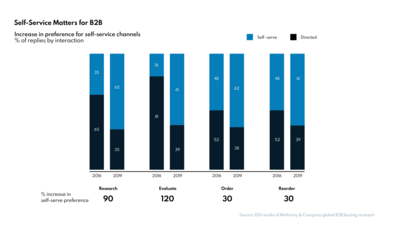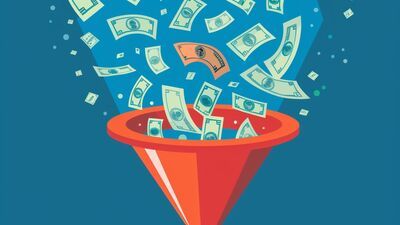
- Summary
- How Does a Recession Affect Marketing?
- 1. The Pressure to Prove Marketing ROI Rises
- 2. Alignment Between Marketing and Sales Diminishes
- 3. Targeting Misses the Mark As Customer Dynamics Shift
- 4. Customers Shift Focus to Value-Based Marketing
- 5. Demand Gen and ABM Require Rebalancing
- Why Investing in Marketing During a Recession is the Right Decision
- 1. Maintain Market and Mindshare
- 2. Keep Competitors at Bay
- 3. Grow Brand Awareness
- 4. Maintain Visibility of Marketing Dynamics
- 5. Retain Current Customers
- 6. Capitalize on Competitor Customer Churn
- Seven Recession-proof Marketing Strategies to Consider
- Dos and Don’ts of Marketing During a Recession
- Recession Marketing Strategy Recap: Don’t Beat the Recession, Ride It
B2B marketing during a recession requires a careful rethink of marketing strategies to neutralize the adverse effects of an economic downturn. Companies may need to add a permanent chapter on how to market during a recession in their marketing playbooks because economic recessions are cyclical, occurring on average every ten years.
Economists and financial analysts believe they are the inevitable result of the business cycle in capitalist economies. For businesses and their customers, a decline in economic activity during recessions causes uncertainty and the need to shift priorities to accommodate the more challenging times.
While customers tighten their belts and shift spending to more needful expenses, businesses face a crossroads, weighing which costs to retain, cut, or eliminate.
Unfortunately, marketing is often one of the first casualties of such austerity measures for the following reasons:
- Marketing is viewed as a cost center, not a revenue driver like sales
- Marketers, using terms like marketing spend, further enhance the narrative that marketing is a cost center
- Marketers often do not tie marketing investment with revenues, which makes it difficult to justify further investment
- Most businesses do not understand the underlying effect of marketing on powerful aspects like brand recognition, market share, and community building.
Cutting marketing investments during a recession is a mistake unless done for survival purposes. This article explores in detail why businesses must double down on marketing during a recession, even when everyone else heads in the opposite direction.
How Does a Recession Affect Marketing?
Marketing is one of the hardest hit business functions within organizations during an economic downturn. In the hierarchy of priorities, it loses out to production, sales, and customer experience.
However, it’s not that marketing is not a helpful department; it’s because economic recessions bring marketing into sharp focus, making it imperative for marketers to adopt better strategies to show the value that marketing drives.
During an economic recession, marketers must address the following factors that can drastically affect their ability to drive value for the organization and justify further investment.

1. The Pressure to Prove Marketing ROI Rises
In a bullish market, marketing often benefits from the coincidental rise in sales opportunities. Customers are doing well financially, so they are ready to buy even if marketing efforts are not as effective.
In a downturn, these organic opportunities shrink, putting pressure on marketing to demonstrate marketing ROI through revenue attribution.
Within this environment, marketers find it difficult to verify ROI due to:
- a lack of revenue-based goals,
- poor CRM lead tracking,
- no attribution software (or improperly configured),
- a lack of customer surveys,
All of which, when implemented correctly, accurately express revenue attribution.
2. Alignment Between Marketing and Sales Diminishes
Market downturns put pressure on an already tenuous relationship between sales and marketing. As leads diminish, each party can resort to their own devices, forgetting that marketing and sales alignment is the path to success.
One study found that sales and marketing alignment led to a:
- 208% increase in revenue.
- 36% in customer retention.
- 38% increase in deal closure.
During a recession, sales and marketing face the challenge of retaining and enhancing alignment and developing coordinated approaches to shrinking marketing opportunities.
For instance, deepening customer relationship management by developing more detailed personas and Know Your Buyer (KYB) matrices for use across both departments.
3. Targeting Misses the Mark As Customer Dynamics Shift
In a recession, customer spending habits shift to accommodate changing market conditions. They will reduce, replace, or remove costs that they initially had, significantly impacting marketing effectiveness.
For marketers, this shift means marketing campaigns that target specific personas or markets can become ineffective, especially if they are not regularly updated. In such a scenario, marketing can increase ad spending and still get worse results than in pre-recession periods.
A lack of granular analysis of customer dynamics and changing spending habits can severely curtail marketing effectiveness, causing wastage and poor revenue attribution.
4. Customers Shift Focus to Value-Based Marketing
Recessions erode customer confidence and trust, forcing them to become price sensitive and rethink and reevaluate purchasing decisions from a value perspective. Most will want to know whether they are getting maximum value for money spent.
This shift can reduce marketing effectiveness, especially if current marketing efforts are feature-based. Messaging that extols a product's or service's qualities might not bear fruit as successfully.
As such, marketing in a recession presents the unique challenge of transitioning to customer-centric value-based marketing by adjusting content, messaging, and goals to demonstrate value and cultivate trust.
5. Demand Gen and ABM Require Rebalancing
One-to-many marketing techniques like demand generation often thrive in a bullish market. There are more leads in the market, so there are more chances of snagging leads. However, in a bear market, such efforts amount to a spray-and-pray approach that often proves wasteful.
On the other hand, ABM can have better results in a lead-poor market because it focuses on relationship-building and value-based marketing. Despite this, ABM does not negate the need for demand gen.
B2B marketing in a recession requires balancing demand gen and ABM based on revenue attribution, internal resources to support each effort, and overall sales and marketing goals.

Explore How to Run Successful ABM Campaigns During A Recession
Why Investing in Marketing During a Recession is the Right Decision
From the previous section, it’s clear that marketing still has a critical role to play during a recession. If anything, when closely aligned with sales, they represent an engine for growth that can defy the laws of an economic downturn.
The next question is, should you reduce, increase or maintain advertising budgets through a recession when resources are limited, and you must prioritize spending for maximum revenue impact?
The answer to this question lies in understanding the multifaceted role marketing plays during a recession, besides just acting as a lead generation machine.
Here are the top reasons why you should maintain, and even increase, if possible, investments in marketing through a recession:
1. Maintain Market and Mindshare
One of the dangers of cutting marketing spend during a recession is the risk of losing market and mindshare. When you are actively marketing, you are generating leads, yes, but also cultivating market and mindshare.
Your customers and those who have heard about you know you exist, and if not now, they can become future customers. Curtailing marketing investments stops market share and mindshare growth and imposes a regression.
With less marketing, your brand starts fading from prospects' minds, shifting their attention to competitors who might be maintaining or even increasing marketing investments to grow market and mindshare.
2. Keep Competitors at Bay
Competitors would love to take your lunch, especially in a market where you are perceived as being in a weakened position. Clever competitors will analyze your marketing patterns and exploit any weaknesses they identify.
Reduced marketing investments indicate that your business is vulnerable and can trigger raiding incursions by competitors into your market segment—continued investments in marketing signal that you are still in the ring and ready to trade punches.
However, considering possible internal resource restrictions, it requires innovative and fine-tuned marketing campaigns that surgically address marketing gaps while eliminating other non-critical efforts.
3. Grow Brand Awareness
Recessions create a unique opportunity for brands to position themselves for tremendous growth when the upturn comes around. According to a Bain and Capital analysis, recessions create 47% more rising stars than during stable times, indicating a tremendous opportunity for new market leaders to emerge from a recession.
Brand awareness plays a pivotal role during this time. By winning more mindshare, brands can position themselves to be top-of-mind when the economic downturn reverses, and customers start shopping for products and solutions with revamped budgets.
On the other hand, brands that don’t invest in brand awareness risk bolting out of the gate when the rest of the pack is already halfway down the track.
4. Maintain Visibility of Marketing Dynamics
Slowing down marketing reduces the amount of data from various marketing properties and tools. Similarly, maintaining or increasing investments in marketing keeps this data flowing.
Why is this important?
In bullish, stable, or bearish markets, having a clear picture of what is happening, including customer behavior, competitor analyses, and so on, is critical to maintaining competitiveness.
Investing in marketing generates this data through website analytics, persona development, surveys, app analytics, CRM tracking, and others, providing crucial insights into the market at any given time and informing revenue-generation strategies.
5. Retain Current Customers
Your customers want to know you are alive and kicking throughout the recession. With the uncertainty that economic downturns bring, customers often look to brands for reassurance that things are not as bad as they appear.
Cutting investments in marketing, for example, pulling an event sponsorship or halting a paid partnership, can signal to customers that a brand might not be doing very well, hurting the perception and image it has built over the years.
Continued investments in marketing protect a brand’s image and secure its position in its customers’ eyes, maintaining their confidence that the brand will continue delivering on its mandate despite the recession.
6. Capitalize on Competitor Customer Churn
Recessions occasion significant customer churn as customers realign their purchases by adjusting budgets and priorities.
The reasons for churning are varied:
- moving to a cheaper option,
- seeking a higher-priced, higher-value offering,
- switching to a similarly priced alternative with more value,
- the current choice is no longer available,
- etc.
Continued investments in marketing enable a brand to expand share of voice, capitalize on this customer churn, and win new customers from competitors.
When customers come into the market seeking these alternatives, presenting value-based messages can quickly turn them into customers with less effort considering most other brands might not be aggressively marketing during a recession.
Looking to Boost Your Recession Marketing Efforts at a Fraction of the Cost?
Seven Recession-proof Marketing Strategies to Consider
Marketing during a recession requires a rethink of strategies to better respond to the challenges of shifting market dynamics. However, before radically changing marketing strategies, evaluating your current situation and position is crucial.
The figure below provides a general assessment of the best line of action, depending on factors like strategic position and financial strength.

Regardless of which quadrant your business occupies, you can apply the recession-proof marketing strategies below, adjusted for goals and priorities.
1. Introduce and Maintain Agility
Recessions can last for two or ten years, making a ride-it-out mindset dangerous, especially if the company is burning cash. This mindset is especially true when it comes to marketing. If marketers have a rigid perspective, they might consider maintaining the same strategies and approaches even though the market has changed.
Understanding that it is no longer business as usual is a crucial adjustment to unlocking the rest of the strategies below. Marketers can introduce agility through a change in mindset and culture. For example, they can adopt a mentality of experimenting and making smaller data-driven gambles and a culture of better sales and marketing alignment, both of which can make them more agile.
2. Turn off Nice-to-Have Campaigns
Nice-to-have campaigns have no clear ROI or revenue attribution or do not align with adjusted goals and current market conditions.
Data from IAB indicates that 63% of marketing decision-makers shifted their ad dollars to mission-based marketing, cause-related campaigns, or building brand equity in response to changing market conditions at the height of the pandemic.
This data indicates that shifting marketing investments to more impactful areas is crucial to maintaining marketing momentum, generating quantifiable ROI, and reducing wastage.
3. Double Down on Revenue Attribution
Unlike conversion tracking, which only quantifies actions, revenue attribution or marketing attribution connects specific actions generated by marketing campaigns to revenue.
In a downturn, knowing which marketing efforts are generating revenue is critical because when in survival mode, dollars are more important than clicks.
Another function of revenue attribution in a recession is disabusing the notion that marketing is a cost center. As marketers compete for scarce resources with other departments, they must clearly show a direct correlation between marketing investments and revenue.
Doubling down on revenue attribution and generating correlative data can strongly argue for maintained or increased marketing investments.
4. Commit More Resources to ABM
Interest in the search term ‘account-based marketing strategies’ has increased 60% from mid-2021 to mid-2022, signaling a shift in focus for marketers.
ABM provides a strategic approach to combining targeted, insight-led marketing with sales to strengthen relationships, increase mindshare, and drive growth in specific new and existing accounts.
ABM in a recession is crucial to retaining key accounts through trust and relationship building while cost-effectively going after targeted new accounts. However, marketers must first consider whether ABM is a good fit for the company.
For companies that don’t fall in the ‘challenger brand’ bucket (e.g., they are market or niche leaders), a more traditional demand generation program may be a better fit.
5. Analyze Data for Customer and Market Patterns
Recessions change market conditions, sometimes significantly, pushing customers to alter purchasing patterns and choose between essentials, treats, postponables, and expendables, as this Harvard Business Review article shows.
Customers who previously defined a niche migrate into other niches or create new ones, while purchasing patterns shift to reflect reduced purchasing power or more cautious expenditures.
To avoid barking up the wrong tree, marketers must collect and analyze as much data as possible, including conducting market research, to understand how the recession affects their target audience.
For instance, if metrics shows that a target niche is significantly impacted by the recession and might not have as much purchasing power, it might be an opportunity to offer new products or support them in other ways to maintain share-of-mind and preserve relationships.
6. Invest More in Brand-building Initiatives
Brand-building efforts don’t go to waste during a recession. They offer multidimensional benefits that can increase marketing effectiveness while lowering marketing costs.
Here are the top reasons why brand-building should be part of your recession marketing plan:
- Awareness – Brand-building increases brand awareness and recognition, making it easier to start conversations with potential leads.
- Loyalty – The perception of a strong and consistent brand cultivates loyalty and can generate repeat business from current and past clients.
- Referrals – Customers will recommend companies they perceive as consistent, strong, and focused.
- Humanize – During a recession, people are more risk-averse and less confident. Brand building can humanize a brand, infusing it with empathy that can establish an emotional connection with the customer base.
- Advertising effectiveness – If people are aware of your company or brand, your ads will meet familiarity and positive reception, possibly increasing effectiveness and lowering costs.
7. Publish More Value-based Content
Digital sourcing continues to be a growing trend in B2B as an emerging crop of managers prefer digital channels to find solutions.
Riding on the back of this trend is a rising preference for self-service channels, as the figure below shows:

Marketers can capitalize on this trend by embracing content marketing and publishing more content targeting the middle and bottom of the funnel to emphasize value, build relationships, and shorten the conversion cycle.
The focus should be on content types most used to research B2B purchasing decisions: case studies, white papers, SEO blog posts/articles, reports/analyses, and eBooks, in order of priority.
Dos and Don’ts of Marketing During a Recession
The previous sections cover how a recession affects marketing, why you should invest in marketing during a recession, and what recession-proof strategies you can adopt for better marketing performance.
This section provides a summary of marketing tactics to adopt during an economic crisis:
Dos
- Do use more strategic marketing automation to accelerate data collection, processing, analysis, and insight generation.
- Do get rid of marketing bloatware – software and tools that do not enhance your marketing effectiveness.
- Do consider bringing in outside marketing help, especially to brainstorm innovative approaches and streamline, fine-tune and optimize current campaigns.
- Do retain your current marketing budget BUT repurpose it for more contextual and targeted marketing efforts.
- Do focus on the competitive landscape and what competitors are doing to market effectively in a recession.
- Do prepare for more hit or miss scenarios as you implement the various strategies laid out above, and establish an experiment-based approach.
Don’ts
- Don’t invest in more tools without understanding how they impact marketing outcomes.
- Don’t throw more ad dollars at advertising without data to back additional advertising spend.
- Don’t confine yourself to a rigid marketing playbook that does not reflect changing marketing dynamics.
- Don’t forget to utilize social media marketing, especially LinkedIn.
- Don’t ignore your website and its power to support other marketing efforts.
- Don’t be impatient, jumping from one strategy to another without giving each one enough time to generate data and provide valuable insights on performance.
- Don’t be discouraged when results are underwhelming; use the data you collect to fine-tune and undertake optimization of subsequent campaigns.
Recession Marketing Strategy Recap: Don’t Beat the Recession, Ride It
B2B marketing during an economic crisis is like learning how to surf. The idea is not to resist or overcome the wave but to ride it.
As noted at the beginning, most recessions follow a cyclical economic pattern of robust growth followed by a downturn. In this recession, what is different from previous recessions is that it is not clear how long it will last because there isn’t one single cause—instead, there is a confluence of post-coronavirus-pandemic factors.
Marketers must adjust their short-term marketing plans, strategies, objectives, and ad budgets to accommodate the emerging market shifts and better meet customer needs.
At O8, we understand this need. Our digital marketing experts are on hand to help you course-correct for better results while working within your online advertising budget and helping you win more business cost-effectively.







